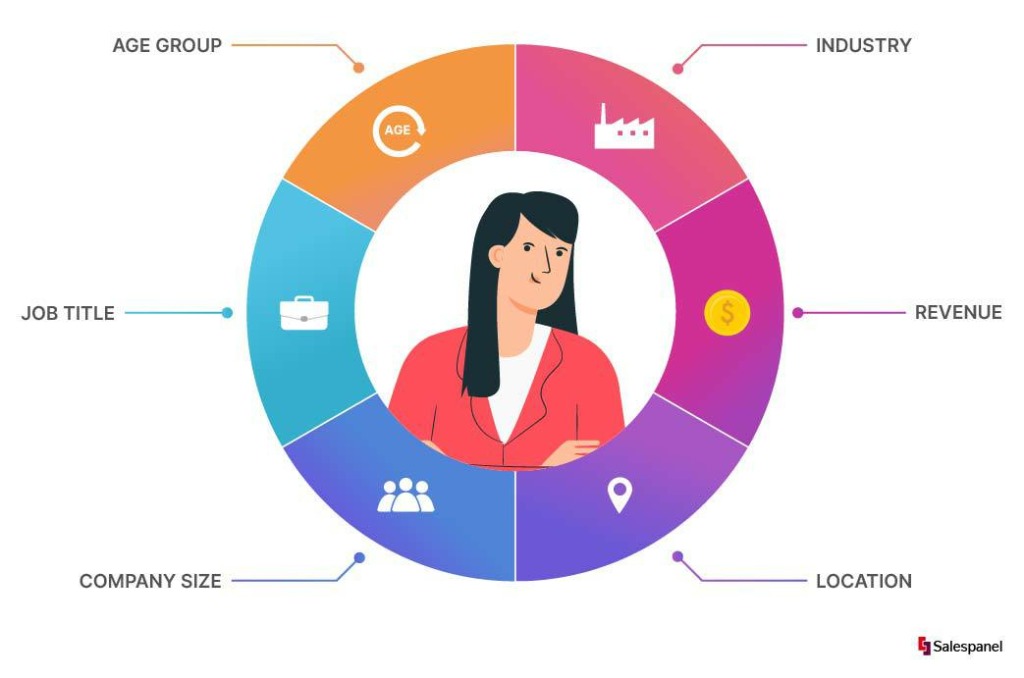Building a laser-focused framework to clearly define your ideal customer profile (ICP) provides the missing blueprint to target accounts with precision and enhance experiences across the board.
Want to build an ICP that acts as a North Star guiding your marketing, sales, service, and product teams? This comprehensive guide will walk you through a proven step-by-step framework.
Learn how to leverage data-driven insights about current customers, carefully crafted buyer personas, and segmentation to build ICPs that generate tangible ROI. Plus, take advantage of templates and software that make it easier than ever to build an ideal customer profile.
With clearly defined ICPs powering your business, you can focus your efforts on attracting and serving the accounts that provide maximum value.
Understanding the Ideal Customer Profile (ICP)
For a business to thrive in today’s competitive landscape, it’s essential to have a deep understanding of your ideal customers. This is where developing an Ideal Customer Profile (ICP) provides immense value.
What is an Ideal Customer Profile (ICP)?
An ICP is a detailed description of your perfect customer. It includes firmographic, demographic, and psychographic attributes to paint a holistic picture. An ICP focuses on the organization as a whole, rather than individual buyer personas.
Here are some examples of key elements in an effective ICP:
- Industry Vertical: The specific industry your product or service caters to. For example, a HR SaaS tool may target mid-size tech companies.
- Company Size: Number of employees or revenue that indicate an ideal customer. Such as $10M – $50M in annual revenue.
- Location: Geographical area your solution works best for. For instance, companies based in the UK or North America.
- Technologies Used: Tools, software, or systems an ideal customer relies on. Such as Salesforce, Office 365, AWS, etc.
- Budget Range: The budget an ideal customer has available for your type of product or service.
- Organizational Traits: Details like organizational structure, customer base, tech maturity, etc.
In essence, your ICP is your ideal “dream” customer that perfectly fits your offerings and provides maximum value.
Why is an ICP Critical for Business Success?
Defining your ICPs brings several benefits that directly impact revenue and growth:
- Focused Marketing: You can create targeted campaigns tailored to your ICPs specific needs and challenges. This results in higher conversion rates.
- Qualified Leads: Sales teams can better prioritize leads that closely match your ICP criteria. This speeds up sales cycles.
- Lower CAC: With targeted marketing and sales, you lower customer acquisition costs by reducing time and effort spent on low-potential prospects.
- Increased Retention: You can anticipate needs, reduce churn, and strengthen retention by building products and services your ICPs value.
- Higher LTV: Focusing on your ideal customers increases lifetime value. ICPs are more likely to have higher order values, renew contracts, and expand usage.
- Product-Market Fit: Keeping your ICP front and center helps ensure you build features and capabilities that directly address your best customers’ pain points.
Differences Between an ICP and Buyer Personas
While ICPs and buyer personas are complementary, they serve different purposes:
- ICP focuses on the organization as a whole and its attributes. It defines the ideal type of company.
- Buyer Personas zero in on the individual decision makers and users within target ICP companies. They detail personal attributes like demographics, challenges, and motivations.
Think of ICPs as a 30,000 foot view of your ideal customers, while buyer personas take a closer look at the actual people inside those organizations.
To be successful, you need both! ICPs help you identify high-potential accounts, while buyer personas allow you to craft targeted messaging and experiences that resonate at a personal level. Together, they provide a complete view to help you attract, serve, and retain ideal customers.

Key Steps to Build a Strong ICP Framework
Developing a rock-solid ICP takes time and effort, but following a proven framework can make the process much smoother. Here are the key steps:
Analyze Your Current Customer Base
Your existing customers offer a wealth of data to help define your ICPs.
Identify Common Attributes and Behaviors
Look for trends and patterns among your current customers. What attributes do they share? What needs drove them to purchase from you? Identify commonalities like:
- Industry and sub-industry
- Revenue range
- Number of employees
- Tech stacks
- Roles and departments
- Success metrics
These form the foundation of your ideal customer criteria.
Conduct Surveys and Interviews
Gather direct input from your happiest customers via surveys and interviews. Ask targeted questions to uncover:
- What pain points they aimed to solve
- How they discovered your brand
- What convinced them to buy
- How they measure success
- What they value most
This qualitative data brings your ICPs to life.
Review Past Campaign Metrics
Analyze historical marketing and sales data to identify which segments have been most responsive. Look at:
- Lead origin
- Conversion rates by campaign
- Sales by lead source
- Churn rates
These behavioral insights supplement firmographic and demographic data.
Research Your Competition
Gaining perspective into who your competitors are targeting provides another useful angle.
Study Their Messaging and Offerings
Review competitor messaging, content, and product positioning through their sites, blogs, and collateral. Note the use cases, pain points, and benefits they promote. This shows you who they want to attract.
Analyze Their Customer Base
Explore existing customer testimonials and case studies. Check their social media and ads for common audiences. This reveals who their current customers are.
Evaluate if there are differences in ICPs you can capitalize on.
Define Your Target Customer Criteria
With thorough research completed, synthesize learnings to define your ideal customer criteria across four facets:
Firmographic Qualities
Details like industry, company size, revenue range, and technology used that indicate fit. Prioritize 2-3 must-have traits.
Demographic Details
Attributes of the actual buyer personas like title, role, seniority, and location.
Psychographic Attributes
Motivations, values, preferences, and decision-making approach of your best customers.
Geographic Considerations
Regions, markets, or locations an ideal customer operates in.
Aim for an ICP definition that is focused yet flexible enough to attract high-potential matches beyond a rigid formula.
Create Detailed Buyer Personas
With target ICPs defined, develop detailed buyer personas that bring your ideal customers to life.
Map Their Buying Journey
Outline the typical stages and processes an ICP goes through in discovering, evaluating, and purchasing your type of offering.
Outline Their Pain Points
Document the frustrations, challenges, and needs an ICP aims to solve specifically.
Define Their Goals and Motivations
Capture what an ideal buyer persona ultimately aims to achieve both personally and for the business.
Fleshing out ICP personas helps craft resonant messaging.
Build ICP Profiles for Each Target Segment
With your criteria set and buyer personas developed, group ICPs into targetable segments. Common ones include:
Best-Fit Customers
Accounts that match your ICP criteria closely. They perfectly fit your solutions.
Good-Fit Prospects
Accounts that meet some but not all ICP criteria. They have high potential.
Poor-Fit Accounts
Accounts that are misaligned to most of your ICP criteria. Pursuing them brings lower ROI.
Segmenting allows personalized marketing and sales approaches based on fit.
Continuously Optimize Your ICP
Your ICPs are not set in stone. Consistently optimize them with new data.
Review and Revise Quarterly
Set aside time every quarter to review your ICP framework. Have any new patterns emerged in your customer base? Does your ICP still reflect your best-fit accounts?
Incorporate New Data and Trends
Update target customer criteria and personas to align with new data, trends, products, or positioning. Evolving your ICP keeps it current.
Following this comprehensive framework results in an ICP methodology based on real customer intelligence that generates tangible business value.

Leveraging Your ICP Framework for Success
An ICP framework is invaluable, but only if you actively leverage it across your customer-facing teams. Here are key ways to drive value from your ICPs.
Focus Your Marketing Efforts
An ICP eliminates guesswork and focuses your marketing.
Target Accounts Matching Your ICP
Use your ICP fit criteria to identify and prioritize outreach to matching accounts. This allows for more relevant, meaningful engagement.
Craft Messaging Aligned to ICP Needs
Understand your ICPs’ pain points and motivations to inform messaging and content. Tailoring campaigns to your ICPs’ world generates higher conversion.
Qualify and Prioritize Sales Leads
Your sales team can accelerate deals with an ICP guiding lead prioritization.
Identify High-Potential Opportunities
Assess incoming leads against your ICP framework to identify the most promising opportunities worth pursuing first.
Speed Up Sales Process for ICP Matches
Sales cycles shorten when prospect needs and pain points are predetermined. ICP alignment fast tracks deal progression.
Enhance Customer Experience
Keep ICPs top of mind to retain and expand customers.
Anticipate Needs and Reduce Churn
Know common ICP challenges to get ahead of issues and delight them with proactive support. Lower churn retains revenue.
Personalize Service and Support
Tailor your customer service approach based on needs outlined in your ICP personas. Personalization drives loyalty.
Inform Product Development
Build with your ICPs continually in mind.
Build Features ICPs Will Value
Prioritize your roadmap around capabilities that directly address your ICPs’ challenges and goals.
Solve Your Best Customers’ Pain Points
Fixing frustrations your ICPs experience ensures you build for real value, not imagined needs.
In summary, an ICP framework only realizes its full potential when integrated across go-to-market functions. Consistently referencing your ICPs gives your entire organization focus for success.

Tools and Templates to Build Your ICP
Creating an effective ICP framework requires synthesizing data from multiple sources. Using the right tools and templates accelerates the process.
ICP Template Overview
Leverage pre-made ICP templates to simplify drafting profiles.
Long Form ICP Template
An in-depth template covering firmographics, psychographics, and other criteria provides room for detail. Ideal for thorough profiles.
Short Form ICP Template
A condensed template focused just on core attributes enables rapid profile creation. Great for initial drafts.
Buyer Persona Templates
Pre-built persona templates help develop detailed profiles of your ideal buyers.
Detailed Persona Template
Robust templates allow capturing deep insights into personas like motivations, challenges, and process.
One-Page Persona Template
Condensed templates focus on core background, demographic, and psychographic attributes on one page.
Software to Streamline ICP Building
Platforms and tools centralize data required for ICP creation.
CRM Software
A CRM stores key firmographic details on prospects and customers needed for profiles.
Analytics Platforms
Analytics provide behavioral data on site engagement and campaign responses by segments.
Survey Tools
Surveys gather direct qualitative feedback from customers to incorporate.
Leveraging templates and software maximizes efficiency in consolidating quality data to build accurate ICP frameworks.

Sample Ideal Customer Profile Frameworks
Seeing example ICP frameworks can provide inspiration and ideas for crafting your own. Here are a few samples:
ICP Example for IT Company
An ICP for an IT consulting firm helping implement cloud solutions may highlight these ideal attributes:
- Industry Verticals: Mid-market SaaS, ecommerce, fintech
- Company Size: $10M-$50M revenue
- Location: North America
- Technologies Used: On-prem infrastructure, legacy apps
- Key Roles: CTO, VP Engineering, Lead Architects
- Goals: Improve agility, scalability, costs
- Challenges: Legacy tech constraints, lack cloud skills
This shows the firmographic, demographic, and psychographic qualities of an ideal customer.
ICP Example for Recruiting Firm
A staffing agency ICP focused on placing engineers may include:
- Industries: Hardware, software, medical devices
- Company Size: 500+ employees
- Location: Major tech hubs
- Roles: Engineering managers, recruiters, HR
- Goals: Fill tech roles quickly
- Challenges: High competition, high attrition
The geographic focus and roles highlight how specialization comes into play.
ICP Example for Financial Services
A wealth management firm could define an ideal customer as:
- Demographic: $250K+ household income
- Age Range: 55-70 years old
- Location: Tri-state area
- Assets: $1M+ investable assets
- Goals: Retire within 10 years
- Challenges: Complex portfolios, wealth preservation
For B2C firms, personal demographics feature prominently.
These examples showcase how ICPs are tailored to different business models and markets. Use them as inspiration to craft your own framework optimized for your needs!

Key Takeaways
- An ideal customer profile (ICP) provides a detailed overview of your perfect customer, allowing you to focus your efforts.
- ICPs consider firmographic, demographic, psychographic, and geographic attributes to build a 360-degree view.
- Developing thorough ICPs requires analyzing your current customers, researching competitors, and creating buyer personas.
- An effective ICP framework benefits marketing, sales, services, and product teams by focusing efforts.
- Leverage templates, software tools, and real data to efficiently build accurate ICPs.
- Continuously optimize your ICP framework by reviewing it quarterly and incorporating new insights.
- With clearly defined ICPs, you can target the right accounts, offer tailored experiences, and build capabilities your ideal customers value.
- An ICP provides a strategic compass to guide all go-to-market functions toward serving your best-fit customers.
Frequently Asked Questions
Q: How is an ICP different from a buyer persona?
A: An ICP focuses on the organization while a buyer persona targets the individual decision-maker. ICPs take a higher-level view of your ideal customer attributes.
Q: Should my ICP be broad or narrow?
A: It depends on your market. Define 2-3 must-have attributes to focus your ICP, but leave room for flexibility to attract potential high-value accounts beyond a rigid criteria.
Q: What data sources should I use for creating an ICP?
A: Leverage a mix of internal data on current customers, external research on competitors, and direct customer feedback via surveys and interviews.
Q: How often should I update our ICP framework?
A: Review your ICP at minimum on a quarterly basis to incorporate new learnings and trends. You can refine it more frequently as needed.
Q: What tools will help build our ICP?
A: CRM software, analytics platforms, survey tools, and ICP template resources can streamline consolidating data into ICP profiles.
Q: How can we make sure our ICP gets used?
A: Socialize your ICP across departments. Integrate it into processes for marketing, sales, services, and product teams through training and enablement.
Q: What if we serve multiple customer types?
A: Segment your ICP framework into groups based on common attributes. Build personas and tailor targeting for each segment.
Q: How detailed should our buyer personas be?
A: Include enough detail to inform messaging and interactions, but avoid overcomplicating personas. Focus on critical differentiating details.
Q: Who should be involved in building our ICP?
A: Engage marketing, sales, services, product, and customer research teams for a 360-degree perspective.

